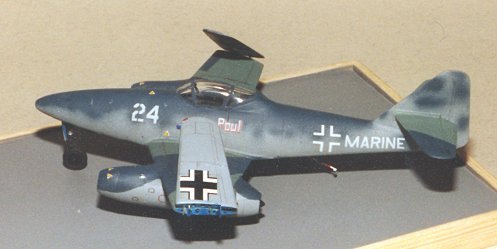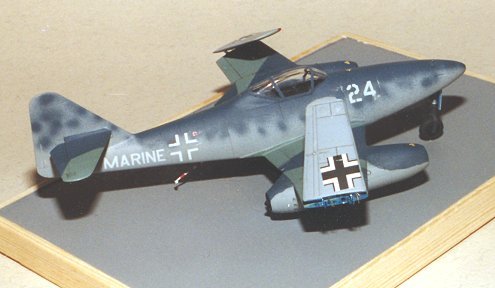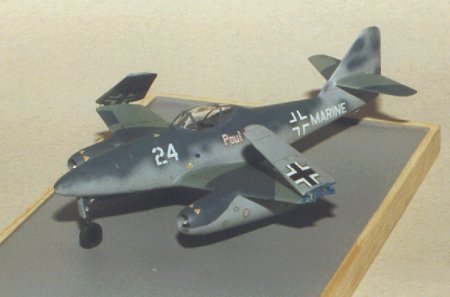
Phake Modelz 1/72 Me-262T 'Seeschwalbe'
Kit # 4598
Price $7.55 (15 Euros)
Decals: one version; SJG 1 in standard late war marine colors of RLM 84/85/86
Review and Photos by Martin Sczepan

Brief History
When in the second half of 1944 the land based version of the Me 262 started to show success, also the Kriegsmarine (the German Navy) became interested in the new jet propelled aircraft types. So on October 19, 1944, the order to develop a new carrier based fighter that should replace the obsolete Bf 109T went to Messerschmitt, Arado and Blohm&Voss. Simultaneously Messerschmitt started to modify the Me 262 design, since a totally new design would require some time and the aircraft carriers 'Graf Zeppelin' and 'Fürst Pückler' were near completition. The necessary modifications included foldable wings, a landing gear suited for flight deck operations, special protection against corrosion and an arrestor hook. The new front landing gear was a longer and slightly angled backwards to obtain better landing deck handling characteristics. This resulted in a steeper angle of the aircraft on the ground. For corrosion protection a translucent blue lacquer -- based on phenolic resin and produced under license from a Japanese company -- was used. The arrestor hook was mounted under the rear fuselage.
After a remarkable short time the first prototype was completed on the December 15, 1944. Some days later it started to the initial flight. This revealed, that the performance of the plane was only slightly reduced in comparison to the land-based version. After the fixing of some minor problems the serial production started in February 1945. From march '45 on the new 'Seejagdgeschwader 1' (SJG 1) was equipped with the Me 262T which got the name 'Seeschwalbe'.
After the successful completition of the flight deck training on the April 20 the 'Graf Zeppelin' started its first combat tour to the northern Atlantic. The Seeschwalbe drew its first blood on May, 11 when Oltn. zur See Erwin Müller downed a Tarpon Mk. I. Without doubt the most famous action in which the Me 262 took part was the sinking of the British aircraft carrier H.M.S. Infamous in August. From October the successor of the Me 262T - the Arado 397 'Basstölpel - was available and replaced the 'Seeschwalbe' within some weeks. Even if the Me 262T had only a short service life it was of essential importance for the Kriegsmarine since it helped to yield experiences with the carrier operation of jet propelled aircraft and to protect the German U-boats in the northern Atlantic from the attacks of the British and American forces.
Except some pre-production aircraft all Me 262T were finished in the 84/85/86 color scheme which was developed for carrier operated aircraft and confirmed in Oberflächenschutzliste 8 Os 262T from February, 29th 1945. The used colors were:
RLM 84 Graugrün (gray green)
RLM 85 Graublau (gray blue)
RLM 86 Lichtgrau (light gray)
By order of the RLM the inscription 'MARINE' (navy) was applied on the rear fuselage behind the Balkenkreuz.
The model

The important carrier version of the 262 has been ignored for a long time by the major kit producers. Now 'Phake Modelz', a small company from Kazakhstan comes to our rescue and produces a kit of this plane in 1/72 scale. Beside two sprues with injected parts the kit contains also a vacuformed canopy and a small fret with photo etched parts. The quality of the plastic parts is good with fine recessed panel lines but - typical for limited run kits - some flash has to be removed. To give the model a more realistic appearance the outer wings are given as separate parts which can be mounted in the folded position. The instruction sheet is good and contains also some historical information.
The construction is straight forward. The rather simple cockpit benefits from the photo etched instrument panel and seat belts. Except the areas around the engine nacelles the fit is rather good. Only minor filling and sanding is required. After attaching the canopy the model was airbrushed with Humbrol enamels (78/96/127). The fit of the outer wings will not be so good in the extended position so I mounted them folded. Small parts are a little bit simplified but still usable. Two decal options are provided - the plane of Oltn. zur See Müller (yellow 11) from the carrier 'Graf Zeppelin' and a plane from the famous 'Infamous' attack (white 24) from the carrier 'Fürst Pückler'. The decals are perfectly in register but a little bit fragile. They react well to Microset/Microsol. After a final coat with Humbrols matt varnish the remaining small parts were mounted.
For the first kit from a new company Phake Modelz' effort is quite good and up to other limited run companies' standards. The kit can be recommended to all modellers with some experience with limited run kits and is a must for all 'Marineflieger' enthusiasts. Only the price of 15 Euro seems to be a little bit to high.

Some Remarks:
Since the article was written for German readers it contains some jokes that can (probably) only be understood by Germans. Here some explanations:
Fürst Pückler: Hermann Fürst von Pückler-Muskau (1785-1871) was one of the most glamorous members of German nobility in the early 19th century. He was not only a famous garden architect and writer of traveling reports but also (probably) the first German to ride in a balloon. Nowadays his fame has faded a little bit and most Germans associate his name with a special type of ice cream (mixed strawberry/vanilla/chocolate) which was also invented by him.
Basstölpel: a gannet (morus bassana), 'Tölpel' in German also refers to an awkward person. So 'Basstölpel' sounds neither very dynamic nor elegant...
April 20: 'Führergeburtstag' - Hitler's birthday
'MARINE' inscription was borrowed from post war times, can be found nowadays on all planes operated by the German navy